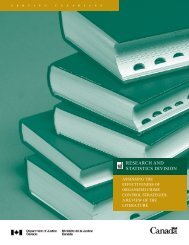National Threat Assessment 2008. Organised Crime - Politie
National Threat Assessment 2008. Organised Crime - Politie
National Threat Assessment 2008. Organised Crime - Politie
Create successful ePaper yourself
Turn your PDF publications into a flip-book with our unique Google optimized e-Paper software.
This section explains how criminals misuse the opportunities offered<br />
by the logistical chain involved in soil remediation.<br />
3.4.2 General context<br />
Before 1980 there was relatively little political or police attention focused on the<br />
problem of seriously contaminated ground in the Netherlands. However, in 1980<br />
the ground in a residential district in Lekkerkerk turned out to be seriously<br />
contaminated by chemical waste.<br />
There are various reasons why the ground gets contaminated:<br />
• dumping/discharging of waste, sludge, process water;<br />
• storage and transhipment of liquids and other materials;<br />
• (former) business activities;<br />
• working with contaminants without taking measures to protect the soil;<br />
• spread from neighbouring sites;<br />
• precipitation spraying the ground with airborne contaminants.<br />
Even though the pollution is often not immediately visible, polluted ground<br />
is equivalent to waste, which gives it a negative value. Remediation gives the<br />
ground a positive value once again, making it usable as a raw material or for<br />
building purposes. The main reasons for soil remediation are making the land<br />
suitable for building on (38%), maintenance of the soil or repairing damage<br />
to the soil (18%), tackling risks involved in current or future use (9%) and<br />
purchasing/selling the land (7%).<br />
However, soil remediation often involves major financial interests, as a result<br />
of which there is frequently a certain tension between ecological and economic<br />
interests. Customers want their ‘problem’ solved for as little money as possible.<br />
Illegal working and pricing agreements have been identified, which, like<br />
malpractice in the construction industry, can continue to exist thanks to the<br />
process of ‘effective non-disclosure’ 44 . The non-disclosure of malpractice stems<br />
from the fact that the soil remediation sector is a ‘small world’ where most of<br />
the players know each other and a small number of players control a large share<br />
of the market. Some of the business people involved believe that the rules for<br />
reusing polluted ground are too strict. This attitude affects the way in which<br />
some people interpret and follow the rules. Another important aspect also plays<br />
44<br />
Term introduced by Van de Bunt (2007). Source: Dienst IPOL, <strong>2008.</strong> Bodemsaneringen. Verslag<br />
van een onderzoek voor het Nationaal dreigingsbeeld <strong>2008.</strong> Korps landelijke politiediensten<br />
(Netherlands Police Agency), Dienst IPOL, Zoetermeer.<br />
chapter 3 – Fraud and money laundering<br />
113








